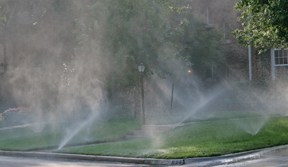By C.L. Fornari

This photo illustrates why having a sprinkler set to “automatic” isn’t usually the best idea. When set to regularly come on and off they end up going off on rainy days when water isn’t needed, or on windy days when more water blows away then reaches the ground.
In the desire to have beautiful lawns and gardens, more people install automatic watering systems every year. While I’m the first one to encourage the pursuit of lovely landscapes, these sprinklers are usually set to go off too frequently, so they are not only squandering a precious resource, but are fostering diseases, creating weed-ridden lawns and producing unhealthy gardens as well.
In this part of the country our lawns and gardens will do well if we receive one inch of rain per week. That’s all it takes for our plants to do well. A perfect rain is one that delivers this inch over the course of a twenty-four hour period, so that the slow rainfall breaks the surface tension of the soil and all of the water soaks into the ground instead of running off. If Mother Nature provides an inch or more of rainwater every seven days, and you’ve mulched around those hydrangeas, you don’t have to water your property at all. This includes the lawn.
Natural processes don’t always come through with that inch or more per week. Many areas in the Northeast have experienced long, dry stretches during the past few summers, and many people have needed to supplement the rainfall with watering. The problem is that more then a few are watering too frequently and too shallowly.
It is common for automatic sprinklers to be set to go off every day, or every other day, for fifteen or twenty minutes. This is just enough water to dampen the soil down three to five inches. If the soil is repeatedly watered to this depth, where are the plants’ root systems going to be? They will be in the top three to five inches of the soil.
Such shallow watering creates plants that are dependant on frequent water because the root layer is so thin. This creates a lawn that is more prone to grub damage, perennials that are more likely to die in the winter, and shrubs and trees that are more prone to falling over in a storm.
And frequent splashing of water also makes plants more prone to fungal problems. Just about every single disease described in my turf-care books lists too much moisture as a contributing factor.
Constantly moist soil also encourages the growth of moss, both in the lawn and in the garden. Because moss prefers continual moisture and lawn grasses do not, the moss will soon outgrow the turf, even in sunny landscapes. Those who water too frequently find themselves in a constant battle with moss. And moss isn’t the only weed that flourishes in damp soil. Lawns that are too wet provide the ideal place for mushrooms to grow and bent grass to get established.
Bent grass is a type of turf frequently planted in golf courses where it is kept mowed very low. When it grows in with common lawn grasses that are cut to around three inches long, bent grass develops long brown stems topped with tufts of fine textured blades. The color of these prominent stems, and the texture of the grass make a lawn infested with bent grass look so ratty and unkempt that homeowners despair. Many end up spending large amounts of money on a lawn restoration, but they seldom realize that the constant moisture supplied by their automatic sprinkler encouraged the problem in the first place.
Those who put new plants in their landscape and rely on these brief but frequent sprinklings often find that their new landscaping doesn’t live. They have a hard time believing that these shrubs and trees dried up, because the sprinklers are coming on every day, or every other day, for twenty minutes. But such a brief watering does not soak the entire root ball, so while the surface of the soil is kept wet, the shallow sprinkling isn’t enough to penetrate deeply enough to keep the new plant alive.
Even established plants suffer when the sprinkler hits them with water on a frequent basis. In the rainforests, where it showers every afternoon around four o’clock, plants are adapted to this daily cascade of moisture. Many of them have the thick waxy leaves we see on Crotons and Philodendrons, two plants whose foliage is tailored to shed the recurrent rainfall.
Plants that thrive in the Northeast, however, are not made to cast off water. Because their leaves hold onto the moisture, it sets up the perfect place for fungi to flourish. Got black spots on your Hydrangea leaves? Are your hosta plants covered with holes and brown, mushy areas? It’s the irritation of the irrigation.
The area where a stem meets the soil is also a place where constantly damp conditions cause fungal growth. Impatiens and begonias are prone to crown rot when kept too wet, and Rhododendrons with constantly damp feet get root rot. A deep soaking less often allows the surface of the soil to dry out, and this is less favorable to the formation of diseases.
To help cultivate a healthy landscape, homeowners should first buy a rain gauge. This tool will show how long it takes your sprinklers to deliver an inch of water. Armed with this knowledge, you can either set the system to water deeply once a week, or better yet, you can turn it on only after a stretch of dry weather when the plants are beginning to look thirsty. Many plants can go even longer than a week after a good soaking.
Irrigation systems that go off too frequently create problems and waste water, and if those who install these conveniences don’t understand this than it’s up to the property owner to request that their system be programmed differently…or not set on automatic at all.
